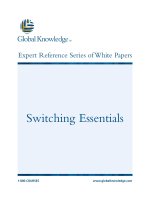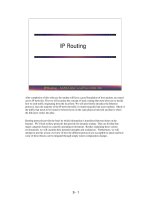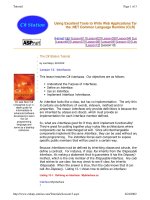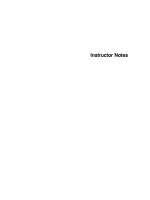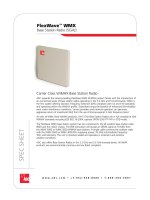Tài liệu Electrical Characteristics pptx
Bạn đang xem bản rút gọn của tài liệu. Xem và tải ngay bản đầy đủ của tài liệu tại đây (320.08 KB, 8 trang )
The AirES product range of cables are a true innovation in
structured cabling. In most evolutionary processes the
gain in one attribute often sacrifices another. With the
AirES evolution all attributes, both physical and electrical,
are improved to provide a "Win Win" situation for both
the installer and customer.
This white paper will focus on the electrical attribute
advantages of AirES. Herein, we will discuss the revolu-
tionary development of the technology and the by-product
effects on any and all electrical parameters. A full glossary
of terms is included for further understanding.
TrueNet
®
AirES
®
Technology
Electrical Characteristics
of the Evolution
TrueNet
®
AirES
®
Technology: Electrical Characteristics of the Evolution
Page 2
Background
To fully understand the benefits of the TrueNet AirES
solution, one must first understand the fundamentals of
cabling and the hurdles overcome by this product.
Good Dielectric Constant is key in producing high quali-
ty data communications cable. The lower the Dielectric
Constant of the insulation material, the better the
resistance to breakdown when an electrical field is
applied. Air, with a Dielectric Constant of 1.0, is the
best of all insulators and is the basis by which others
are measured. ADC has understood this and has been
using air as an insulator in our connectivity products for
many years.
Below is an example of different materials and their
Dielectric Constants. Water, Glass and Air were added
to the list to give a better understanding as to
what constitutes a good Dielectric Constant. It may
be relevant to note the Dielectric Constant of Glass
is higher than FEP insulation. This results in fiber
optic cables having a lower Nominal Velocity of
Propagation (NVP) than UTP copper cables.
The NVP is the speed a signal propagates through a
cable expressed as a percentage of the speed of light
in a vacuum (300 m/sec) and given the value of 1. The
NVP of a data communications cable can be
directly calculated from the dielectric constant of the
insulating material and differs with change in frequency.
The speed of the signal over multi-pair data communi-
cations cable is critical for high speed networks. This
can be attributed to two main factors.
1. The speed at which the signal is traveling (NVP).
2. The total length of the cable pair, which allows for
twist rate.
Both of these parameters combined are measured as
Propagation Delay or the time delay between the sent
and received signal.
One of the byproducts of using FEP as an insulation
material over FRPE is an increase in the NVP due to its
lower Dielectric Constant. The typical NVP of SAME
design cables, using FEP as an insulator over FRPE,
would typically increase up to 4% in NVP, therefore
making FEP a faster insulating material.
Below is a table of typical NVP values for different
cable categories:
Note the Type 1 cables of old had an advantage in NVP
over current UTP designs, coming in at 78%. Type 1
cable is able to achieve much higher NVP values
through the foaming of the insulation materials. This
introduces air pockets within the dielectric. Air has a
much better Dielectric Constant than FEP, thus increas-
ing the signal speed. Type 1 cable was also shielded or
PIMF (Pairs In Metal Foil) cable which allowed for crush
resistance. This may also occur on unshielded foamed
insulation materials.
The AirES Innovation:
ADC’s challenge was to develop a cabling insulation
using air as an insulator, increasing NVP to the same
levels as that of Type 1 cable, and at the same time,
having a high level of crush resistance for UTP applica-
tions. The use of foamed insulation in UTP cables can
prove to have an adverse effect on the integrity of the
structure, as it leaves the cable susceptible to crushing.
By placing solid ribs around the entire conductor, crush
resistance has exceeded the requirements of UL444 by
more than 4X.
Water
PVC
FEP
Polyimide-Glass
Flame Retardant Polyethylene
Air
78.5
4.3
3.6
2.5
2.1
1.0
NVP=
1
√
∑
r
Cable Insulation Transmission Typical
Type Material Type NVP
Type 1 Foamed Token 78%
Polyethylene Ring
Cat 3 PVC 10BaseT 53%
Cat 4 ECTFE 100BaseT4 63%
Cat 5 FRPE 100BaseTX 66%
Cat 5 FEP 100BaseTX 70%
Cat 5E FRPE 1000BaseT 66%
Cat 5E FEP 1000BaseT 70%
Cat 6 FRPE 1000BaseT 66%
Cat 6 FEP 1000BaseT 70%
TrueNet
®
AirES
®
Technology: Electrical Characteristics of the Evolution
Page 3
In the ADC AirES designed cables, AIR combined with
traditional FEP has been introduced as an insulating
material. The result is a NVP that parallels Type 1 cable
and at the same time remains crush resistant.
The total effect of using air combined with FEP as an
insulation material is a 31% reduction in Dielectric Loss.
Here’s how it works.
The equation for working out the Dielectric Loss due to
insulation type where E is the Dielectric constant of the
insulation material and Fp is the power factor of the
material is:
Within the original equation both the Dielectric
Constant and the Power Factor of the material are
reduced with the introduction of air.
The effect is a 31% reduction in Loss due to Dielectric.
The obvious benefit to a reduced dielectric loss is a
direct improvement to signal loss, i.e. stronger signal
strength. This allows for a reduction in copper conduc-
tor size without the sacrifice of performance on
Attenuation, which has a greater impact on the
mechanical attributes.
Through the introduction of air pockets between the
FEP and copper conductor the total Dielectric Constant
is reduced. The capacitive effects are decreased*. This is
then brought back to the nominal 100? by reducing the
outer diameter of the insulation. The total effect is
faster pair transmission on a smaller pair footprint.
The effect of the faster NVP is low Propagation Delay.
Currently the allowable Delay for Cat5e and Cat 6 is
570ns between transmitter and receiver. As mentioned
before, the Propagation Delay is also a function of the
length of the pair, including the twist. The greater the
twist rate the longer the pair. The TrueNet AirES cable is
able to reduce the amount of twist needed for each
pair as well as increasing the NVP.
*Impedance = the square root of the inductance (con-
ductor effects) divided by the capacitance (insulation
effects), or
Loss =
√
∑
diel
9.12f
*
Fp
Cable Insulation Transmission Typical
Type Material Type NVP
AirES Cat 5e FEP and Air 1000BaseT 78%
AirES Cat 6 FEP and Air 1000BaseT 78%
fep
=
2.07
∑
fep
=
1.80
∑
fep
Fp
=
.00030
fep
Fp
=
.0002
2
Or the Dielectric Constant
of FEP
Or the Dielectric Constant
of FEP and Air in AirES
Or the Power Factor of FEP
Or the Power Factor of FEP
and Air in AirES
fep
=
.0039f
Loss
fep
=
.0027f
Loss
Dielectric Loss reduced by 31%
32% less
cross
sectional
area
100
Ω
100
@
Ω
17% Reduced
Distance
AirES AIR pockets as
an insulation material.
Z
=
√
L
C
TrueNet
®
AirES
®
Technology: Electrical Characteristics of the Evolution
Page 4
By reducing the capacitance, impedance is higher. This
can be corrected by reducing insulation size, thus the
AirES invention.
This results in a Propagation Delay of ≤475ns, 17% bet-
ter than the standard. Allowing for a more equal time
delivery on Gigabit Ethernet. This makes the work of
the electronics easier and gives more of a buffer for
error free transmission.
Delay Skew:
Even more critical than the Propagation Delay is the
Delay Skew, the difference in time each signal takes to
arrive on all 4 pairs. For 10/100BaseT transmission this
is not as critical since only 2 of the 4 pairs are being
used for transmission. Delay Skew becomes important
only when we migrate to 1000BaseT (Gigabit) tranmis-
sion, as we are now transmitting on all 4 pairs at the
same time. For optimal performance the signals should
arrive at the receiver as close to the same time as possi-
ble. The standards allow for up to 45nS in delay
between the fastest and slowest pairs. There are other
schools of thought that support a reduction to <25nS.
The AirES cable, due to its fast NVP and reduced need
for twist lay variation operates at a <20nS Delay Skew.
This is unparalleled by any other Category 5e and 6 UTP
cable on the market today. To achieve the Near End
Cross Talk (NEXT) performance, all other manufacturers
must vary the twist lays greatly, increasing Delay Skew.
As illustrated below, it is variation in twist lays which
allows for reduced NEXT within cable. Often to increase
NEXT performance, Delay Skew must be compromised,
“robbing Peter to pay Paul”, so to speak. With the
AirES innovation of introducing Air as an insulator the
Crosstalk is naturally reduced without increasing twist
lay variation. As a function of better insulation through
AIR reducing the dielectric constant and capacitive cou-
pling, there is less Crosstalk between pairs due to
reduced noise. In other words, noise doesn’t travel well
through air!
The total effect of the cable construction is a smaller
cable with better all around electrical performance. In
the example below the old version (industry standard
design) on the left is compared with the new AirES
design. Once jacketed, the effect of having significantly
smaller primary conductors carries through to the final
overall cable outer diameter. The result is a 28% reduc-
tion in cross sectional area for Cat 5e and a 32% reduc-
tion for Cat 6. This translates to greatly increased fill
rate capacity and easier installation.
Note: For more information regarding the mechanical
advantages of AirES please see our "Mechanical
Attributes" white paper.
Quite often in our industry we struggle to understand
the relationship between all parameters testing on UTP
cables. To break it down into simple terms we are inter-
ested in Signal to Noise Ratios (ACR). How strong is the
signal when it reaches the receiver and how much noise
is on the line. Once again, typically increasing the per-
formance of one reduces the performance of the other
or the size of the cable must be increased, but not with
AirES. The Noise (Cross Talk) has been reduced, not by
increased twist rate, but through the introduction of
AIR. This allows the twist rates in each pair to be less,
resulting in a shorter length on each pair. Ultimately
decreasing the amount of Attenuation (Insertion Loss),
thus supplying stronger signal strength.
Propagation delay is the measured time of the signal
from the transmitter to the receiver for each pair.
Delay skew is the difference in time between all
4 pairs for the signal to arrive at the receiver
Incident Signal
V in V out
V next V next
Attenuated Signal
Coupling
0.17” 0.20”
TrueNet
®
AirES
®
Technology: Electrical Characteristics of the Evolution
Page 5
Glossary of Terms
Reproduced with Permission of Fluke Networks
Dielectric Constant:
The property of a dielectric which determines the
amount of electrostatic energy that can be stored by
the material when a given voltage is applied to it. Also
called permativity.
Length and NVP:
Length is defined as the physical or sheath length of the
cable. It should correspond to the length derived from the
length markings commonly found on the outside jacket
of the cable. Physical length is in contrast to electrical or
helical length, which is the length of the copper conduc-
tors. Physical length will always be slightly less than elec-
trical length, due to the twisting of the conductors.
To measure length, a test set first measures delay, then
uses the cable's nominal velocity of propagation to cal-
culate length. Nominal Velocity of Propagation (NVP)
refers to the inherent speed of signal travel relative to
the speed of light in a vacuum (designated as a lower
case c). NVP is expressed as a percentage of c, for
example, 72%, or 0.72c. All structured wiring cables
will have NVP values in the range of 0.6c to 0.9c.
Similarly, if you know the physical length and the delay
of a cable you can calculate the NVP.
In most instances, length is derived from the shortest
electrical length pair in the cable. Because of delay
skew, the length of the four pairs often appears slightly
different. This is normal and no cause for concern with
the exception of significant (over 10%) variances.
Results Interpretation
The main concern when measuring length is that there
is not a lot of cable in any segment. For horizontal
structured cabling this means 100 meters. This is
because applications have been designed to support a
maximum signal propagation delay, and if the link is too
long, this delay could be exceeded. Occasionally
installers may leave excess cable in the ceiling or wall in
anticipation of future needs. While this is okay if it is
considered part of the overall run, tightly coiling excess
cable can lead to undesirable performance degradation
due to additional return loss and near end crosstalk.
Troubleshooting Recommendations
One of the most common reasons for failing length on
a test is that the NVP is set incorrectly. If you are not
careful and use the preset cable type it may not match
the NVP of the cable under test. In this case, you can
have an NVP difference of 10% or more, which trans-
lates directly into a length error. In the event the length
is only slightly too long, check the NVP and cable type.
Assuming the NVP is correct, another cause of excess
length is extra cabling looped in the ceiling or walls.
Does the link in question meet the anticipated plan? For
example, in the case of an airline hanger or warehouse,
a remote station may be forced to be over 100 meters
from the wiring closet. If this has been planned for, and
the intended application supports the excess length,
then the link may fail structured wiring standards but
still be approved for the application. Some field testers
allow customized autotests to be configured that per-
mit variances from standard TIA and ISO/CENELEC
requirements. Such autotests are useful because they
verify the installation meets requirements while allowing
for planned variances.
Pr
opagation Delay:
Propagation delay, or delay, is a measure of the time
required for a signal to propagate from one end of the
circuit to the other. Delay is measured in nanoseconds
(nS). Typical delay for category 5e UTP is a bit less than
5 nS per meter (worst case allowed is 5.7 nS/m). A 100
meter cable might have delay as shown below.
Delay is the principle reason for a length limitation in LAN
cabling. In many networking applications, such as those
employing CSMA/CD, there is a maximum delay that can
be supported without losing control of communications.
Nominal Velocity of Propagation (NVP) on the other
hand, is different. NVP refers to the inherent speed of
signal travel relative to the speed of light in a vacuum
(designated as a lower case c). NVP is expressed as a
percentage of c, for example, 72%, or 0.72c. All struc-
tured wiring cables will have NVP values in the range of
0.6c to 0.9c.
Results Interpretation
Delay measurements are relatively straightforward. Most
structured wiring standards expect a maximum horizon-
tal delay of 570 nS. If design specifications allow, higher
delay can be acceptable.
Since each pair in the cable has its own unique twist
ratio, the delay will vary in each pair. This variance
(delay skew, discussed in the next section) should not
exceed 50 nS on any link segment up to 100 meters.
Standards require all pairs to meet the requirement. It is
possible to report just the worst case pair. This will be
the pair with the highest propagation delay.
Troubleshooting Recommendations
Excessive propagation delay can have only one cause:
the cable is too long. If you fail propagation delay,
check to ensure that the pass/fail criteria match the
design specifications. If so, the cable is too long. In
many cases, a cable up to 25% too long (125m for

